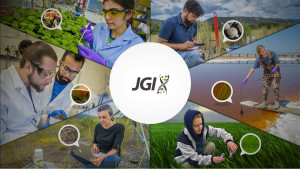Providing the infrastructure for tackling energy, environmental challenges.
 Every year, Earth Day reminds us to continue to provide a cleaner, healthier and sustainable environment for everyone to live in. For those of us who work at the U.S. Department of Energy Joint Genome Institute (DOE JGI) though, every day is Earth Day as our resources provide vital biological infrastructure enabling our thousands of collaborators to address global energy and environmental challenges such as climate change and developing alternative sustainable fuels. Learn more about how national user facilities such as the DOE JGI empower the worldwide research ecosystem here.
Every year, Earth Day reminds us to continue to provide a cleaner, healthier and sustainable environment for everyone to live in. For those of us who work at the U.S. Department of Energy Joint Genome Institute (DOE JGI) though, every day is Earth Day as our resources provide vital biological infrastructure enabling our thousands of collaborators to address global energy and environmental challenges such as climate change and developing alternative sustainable fuels. Learn more about how national user facilities such as the DOE JGI empower the worldwide research ecosystem here.
As U.S. Secretary of State John Kerry noted earlier today while signing the Paris agreement at the United Nations, “We learned that 2015 was the hottest year in recorded history – by far. And we learned that after knowing that the past decade was the hottest on record, and the one before that was the hottest on record. And now we know that this year is already on track to be the warmest of all…. So the urgency of this challenge is only becoming more pronounced.”
- ALASKA: One of the projects we’re tackling with researchers from Berkeley Lab’s Earth Sciences Division, from Pacific Northwest National Laboratory (PNNL), and from the United States Geological Survey. involves understanding what happens to the microbial communities in the frozen Arctic soils as they thaw. With more than 1.5 billion tons of carbon stored in the permafrost, understanding the roles microbes play in controlling its release is crucial. Learn more at http://jgi.doe.gov/characterizing-permafrost-microbes-changing-climate/.
- CALIFORNIA: The DOE JGI is collaborating on a 5-year project with researchers from University of California (UC), Berkeley and will involve scientists at UC Agriculture and Natural Resources, and Pacific Northwest National Laboratory to study how sorghum thrives on limited resources, including water. The work could lead to approaches that can help improve yields of sorghum and other crops under water-limiting conditions both in commercial fields and on marginal lands. Learn more about this at http://jgi.doe.gov/studying-drought-tolerance-sorghum/.
- COLORADO: As part of the Berkeley Lab Genomes-to-Watershed Scientific Focus Area (SFA), our collaborators at UC Berkeley, PNNL, Colorado School of Mines, and Oak Ridge National Laboratory and other institutions are studying how microbial communities at DOE subsurface biogeochemistry field study site in Rifle, Colorado respond to environmental changes, and how these processes impact climate and water quality. Learn more at http://jgi.doe.gov/longer-dna-fragments-reveal-rare-species-diversity/.
- MASSACHUSETTS: The DOE JGI sequences and analyzes fungi to learn how they break down plant mass – information that could be applied to commercial biofuel production – as well as how they interact with plants to help counter disease and other stresses. In a study with Massachusetts collaborators though, researchers looked at how fungi might also be used to clean up contaminated areas. Details at http://jgi.doe.gov/cleaning-up-bunker-oil-with-white-rot-fungi/.
- NEW ZEALAND: Collaborators are also tackling the challenge of reducing methane emissions resulting from activities such as raising livestock. According to the U.S. Environmental Protection Agency (EPA), livestock such as cattle and sheep are the largest sources of methane emissions, a greenhouse gas 25 times more potent than carbon dioxide. We partnered with AgResearch Limited researchers in New Zealand – a nation where sheep outnumber people 7:1 – to characterize and identify the microbes in sheep rumen that are producing methane. The team’s end goal is to mitigate methane emissions without impacting wool and meat production. Learn more at http://jgi.doe.gov/study-reveals-livestock-gut-microbes-contributing-greenhouse-gas-emissions/.